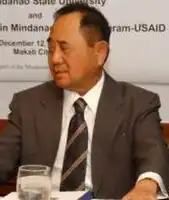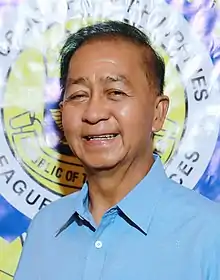| |||||||||||||||||||||||||||||||||||||||||||||||||||||
All 256 seats in the House of Representatives (including underhangs) 129 seats needed for a majority | |||||||||||||||||||||||||||||||||||||||||||||||||||||
|---|---|---|---|---|---|---|---|---|---|---|---|---|---|---|---|---|---|---|---|---|---|---|---|---|---|---|---|---|---|---|---|---|---|---|---|---|---|---|---|---|---|---|---|---|---|---|---|---|---|---|---|---|---|
| |||||||||||||||||||||||||||||||||||||||||||||||||||||
 | |||||||||||||||||||||||||||||||||||||||||||||||||||||
| |||||||||||||||||||||||||||||||||||||||||||||||||||||
 |
|---|
|
|
Elections for the House of Representatives of the Philippines were held on May 14, 2001. This was the next election succeeding the events of the 2001 EDSA Revolution that deposed Joseph Estrada from the presidency; his vice president, Gloria Macapagal Arroyo became president, and her party, Lakas NUCD-UMDP, and by extension the People Power Coalition (PPC), dominated the midterm elections winning majority of the seats in the Senate and in the House of Representatives.[1]
The elected representatives served in the 12th Congress from 2001 to 2004.
Results
District elections
 | |||
|---|---|---|---|
| Party | Seats | +/– | |
| Lakas–NUCD–UMDP | 73 | −38 | |
| Nationalist People's Coalition | 40 | +31 | |
| Laban ng Demokratikong Pilipino | 21 | +21 | |
| Liberal Party | 19 | +4 | |
| Partido para sa Demokratikong Reporma | 3 | −1 | |
| Probinsya Muna Development Initiative | 3 | −1 | |
| Aksyon Demokratiko | 2 | +1 | |
| Pwersa ng Masang Pilipino | 2 | New | |
| PDP–Laban | 1 | New | |
| Partido Demokratiko Sosyalista ng Pilipinas | 1 | New | |
| Not indicated | 20 | +20 | |
| Others | 12 | +12 | |
| Independent | 8 | +6 | |
| Party-list seats[lower-alpha 1] | 51 | 0 | |
| Total | 256 | −1 | |
| Source: Teehankee[2] | |||
- ↑ Only 16 were seated in the party-list election.
Party-list election

On Election Day, parties are guaranteed to win at least one seat if they surpass 2% of the national vote, then another seat for every 2% until it reaches the maximum of three seats per party. However, with the Supreme Court decision on VFP vs. COMELEC, the 2% increments was declared unconstitutional. Instead, the party with the most votes gets at least one seat, then another seat for every 2% until it reaches the maximum of three seats. For parties that got 2% of the vote but did not have the most votes, they will automatically have one more seat, then any extra seats will be determined via dividing their votes to the number of votes of the party with the most votes, then the quotient will be multiplied by the number of seats the party with the most votes has. The product, disregarding decimals (it is not rounded), will be the number of seats a party will get.
For example, for the Association of Philippine Electric Cooperatives (APEC):
Disregarding decimals, APEC won one additional seat aside from one seat they automatically won after surpassing the 2% threshold.
| Party | Votes | % | Seats | |
|---|---|---|---|---|
| Bayan Muna | 1,708,253 | 26.19 | 3 | |
| Association of Philippine Electric Cooperatives | 802,060 | 12.30 | 3 | |
| Akbayan | 377,852 | 5.79 | 2 | |
| Luzon Farmers Party | 330,282 | 5.06 | 1 | |
| Citizens' Battle Against Corruption | 323,810 | 4.96 | 1 | |
| Buhay Hayaan Yumabong | 290,760 | 4.46 | 1 | |
| Anak Mindanao | 252,051 | 3.86 | 1 | |
| Alyansang Bayanihan ng mga Magsasaka, Manggagawang Bukid at Mangingisda | 242,199 | 3.71 | 1 | |
| Philippine Coconut Producers Federation | 229,165 | 3.51 | 1 | |
| Partido ng Manggagawa | 216,823 | 3.32 | 1 | |
| Sanlakas | 151,017 | 2.32 | 1 | |
| Abanse! Pinay | 135,211 | 2.07 | 1 | |
| Adhikain at Kilusan ng Ordinaryong Tao para sa Lupa, Pabahay, Hanapbuhay at Kaunlaran | 126,012 | 1.93 | 0 | |
| Alagad | 117,161 | 1.80 | 0 | |
| Senior Citizens/Elderly Sectoral Party | 106,496 | 1.63 | 0 | |
| All Trade Union Congress of the Philippines | 103,273 | 1.58 | 0 | |
| Maritime Party | 98,946 | 1.52 | 0 | |
| Ang Bagong Bayani-OFW Labor Party | 97,085 | 1.49 | 0 | |
| Aniban ng mga Magsasaka, Mangingisda at Manggagawa sa Agrikultura Katipunan | 65,735 | 1.01 | 0 | |
| Alyansa ng Nagkakaisang Kabataan ng Sambayanan Para sa Kaunlaran | 63,312 | 0.97 | 0 | |
| Alyansa ng may Kapansanan sa Pilipinas | 54,925 | 0.84 | 0 | |
| Mindanao Federation of Small Coconut Farmers Organization | 49,914 | 0.77 | 0 | |
| Womenpower | 46,831 | 0.72 | 0 | |
| Aggrupation and Alliance Farmers and Fisherfolks of the Phils. | 43,882 | 0.67 | 0 | |
| All Workers Alliance Trade Unions | 42,149 | 0.65 | 0 | |
| National Confederation of Tricycle Operators and Driver's Association of the Phils. | 38,898 | 0.60 | 0 | |
| National Federation of Small Coconut Farmers Organization | 37,470 | 0.57 | 0 | |
| Tribal Communities Association of the Philippines | 35,807 | 0.55 | 0 | |
| Pilipinong May Kapansanan | 32,151 | 0.49 | 0 | |
| Veterans Care and Welfare Organization | 31,694 | 0.49 | 0 | |
| Union of the Filipino Overseas Workers | 29,400 | 0.45 | 0 | |
| Pilipino Workers Party | 24,182 | 0.37 | 0 | |
| Democratic Alliance | 24,029 | 0.37 | 0 | |
| Philippine Association of Retired Persons | 23,297 | 0.36 | 0 | |
| Alliance of Retired Postal Employees and Senior Citizens | 22,497 | 0.34 | 0 | |
| Agrarian Reform Beneficiaries Association | 22,345 | 0.34 | 0 | |
| Federation of Jeepney Operators and Drivers Association of the Phils. | 21,335 | 0.33 | 0 | |
| Gabay ng Manggagawang Pilipino Party | 17,777 | 0.27 | 0 | |
| Alternative Approaches of Settlers Advocacy for the Holistic Advancement of the Nation Party | 16,787 | 0.26 | 0 | |
| Alliance for Youth Solidarity | 15,871 | 0.24 | 0 | |
| Party for Overseas Workers and Empowerment and Re-Integration | 13,050 | 0.20 | 0 | |
| Kilos Kabataang Pilipino | 11,170 | 0.17 | 0 | |
| Kaloob-Ka Isang Loob para sa Marangal na Paninirahan | 9,137 | 0.14 | 0 | |
| Alyansa ng Mga Mamamayan at Magdaragat Sa Lawa ng Laguna | 7,882 | 0.12 | 0 | |
| Partido Katutubong Pilipino | 6,602 | 0.10 | 0 | |
| Development Foundation of the Philippines | 6,600 | 0.10 | 0 | |
| Total | 6,523,185 | 100.00 | 17 | |
| Valid votes | 6,523,185 | 43.15 | ||
| Invalid/blank votes | 8,595,630 | 56.85 | ||
| Total votes | 15,118,815 | – | ||
| Registered voters/turnout | 36,271,782 | 41.68 | ||
| Source: Supreme Court (G.R. No. 147589); COMELEC (Canvass report (archived)) | ||||
See also
References
- ↑ Quezon, Manuel III (2007-06-06). "An abnormal return to normality". PCIJ.org. Archived from the original on 2010-11-29. Retrieved 2010-12-06.
- ↑ Teehankee, Julio (2002). "Electoral Politics in the Philippines" (PDF). In Croissant, Aurel (ed.). Electoral Politics in Southeast and East Asia. Singapore: Fiedrich-Ebert-Siftung. pp. 149–202 – via quezon.ph.
- Paras, Corazon L. (2000). The Presidents of the Senate of the Republic of the Philippines. ISBN 971-8832-24-6.
- Pobre, Cesar P. (2000). Philippine Legislature 100 Years. ISBN 971-92245-0-9.
- Teehankee, Julio. "Electoral Politics in the Philippines" (PDF). quezon.ph. Retrieved 2010-12-06.


.png.webp)